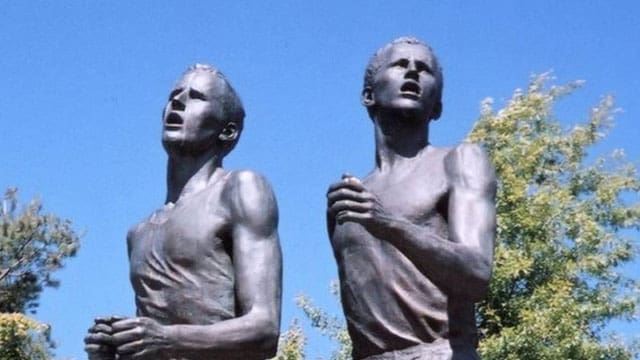Roger Bannister was the first man to break the four-minute mile, but John Landy topped it a mere 46 days later
 It’s been 70 years. But if you were around in 1954, you couldn’t escape the four-minute mile.
It’s been 70 years. But if you were around in 1954, you couldn’t escape the four-minute mile.
The newspapers were full of it, and the coverage wasn’t confined to the sports pages. Running a mile in under four minutes was something nobody had ever done before, and there were even those who doubted whether the human body was up to the challenge.
Until then, the fastest recorded mile had been by Sweden’s Gunder Hagg in the summer of 1945. But Hagg’s time was a second and a half away from breaking the four-minute barrier, and nobody had been able to shift it downwards in the ensuing nine years.
Not everybody bought into the “mission impossible” hype. For instance, English athlete Roger Bannister – then a final-year Oxford medical student – thought the idea was nonsense. And he wasn’t the only one.
As Bannister perceived it, the fact that nobody had improved Hagg’s time was likely a function of straitened conditions in the immediate post-war world. Physically, he saw no reason to believe that Hagg had hit the limit of human performance.
 The famous race between Roger Bannister and John Landy was immortalized by a statue in Vancouver. |
| More by Pat Murphy |
| Peter O’Toole is Ireland’s greatest screen actor
|
| How conventional wisdom can change over time
|
| Brian Mulroney was a foreign policy superstar
|
The Australian John Landy was of a similar mind. A freshly minted agricultural science graduate from Melbourne, Landy had enjoyed an impressive southern hemisphere season and was now heading north to continue his quest.
However, competition from Landy wasn’t the only thing motivating Bannister. He’d also decided that 1954 was going to be his last season as a competitive athlete. At the age of 25, he would quit running to focus on his medical career.
Timing thus being critical, Bannister planned to make his move in Oxford, England, on May 6, 1954. To help, two friends agreed to act as pacemakers. But when the day dawned, the windy weather didn’t look hopeful and Bannister considered calling the attempt off.
Then two things intervened.
One was the blunt admonition from his coach, the Austrian expatriate Franz Stampfl: “If you pass it up today, you may never forgive yourself for the rest of your life.” And the other was the fact that the wind died down.
So, with a time of three minutes 59.4 seconds, Roger Bannister sailed into history as the first man to run a mile in under four minutes. Landy topped that a mere 46 days later, courtesy of a three-minute 58-second mile in Turku, Finland.
With Bannister as the first and Landy as the fastest, the debate raged as to who was the world’s top miler. The acid test, Bannister believed, would be a race where the two competed head-to-head, which came to pass at the Empire Games in Vancouver on August 7, 1954.
As was his style, Landy ran mostly from the front, opening up a gap that stretched to as much as 15 yards; but Bannister’s famous finishing kick on the final bend took him past Landy on the home straight. And a larger-than-life bronze sculpture subsequently captured the critical moment – Landy looking over his left shoulder while Bannister passed him on the right.
Part of what made Landy so personally likable was the wry humour that was never far from the surface, his reaction to the sculpture being a case in point: “While Lot’s wife was turned into a pillar of salt for looking back, I am probably the only one ever turned into bronze for looking back.”
Still, although he never complained or begrudged, the loss did sting. As he confessed years later, “I keep running that Vancouver race on the theory that if I rerun it a thousand times, the results will at least once be reversed, but it hasn’t happened yet.”
Bannister and Landy were of a type that is virtually unrecognizable today. Bona fide amateurs, they competed for the challenge and the glory, not for financial gain. And their training and dietary regimes would appear laughably simplistic by modern athletic standards. Bannister, for instance, favoured beans on toast as his post-training meal.
They also lived long and fruitful lives beyond the track.
Bannister became an eminent neurologist, authoring more than 80 papers. He always said it was the thing he was most proud of. Landy wrote two books on natural history and served as the appointed Governor of Victoria between 2001 and 2006.
Sadly, both men struggled with Parkinson’s disease in their final years. Bannister died at 88 in 2018. Landy followed four years later at 91.
The 1950s were a different time and its celebrities reflected that. The past is indeed “a foreign country.”
Troy Media columnist Pat Murphy casts a history buff’s eye at the goings-on in our world. Never cynical – well, perhaps a little bit.
For interview requests, click here.
The opinions expressed by our columnists and contributors are theirs alone and do not inherently or expressly reflect the views of our publication.
© Troy Media
Troy Media is an editorial content provider to media outlets and its own hosted community news outlets across Canada.


